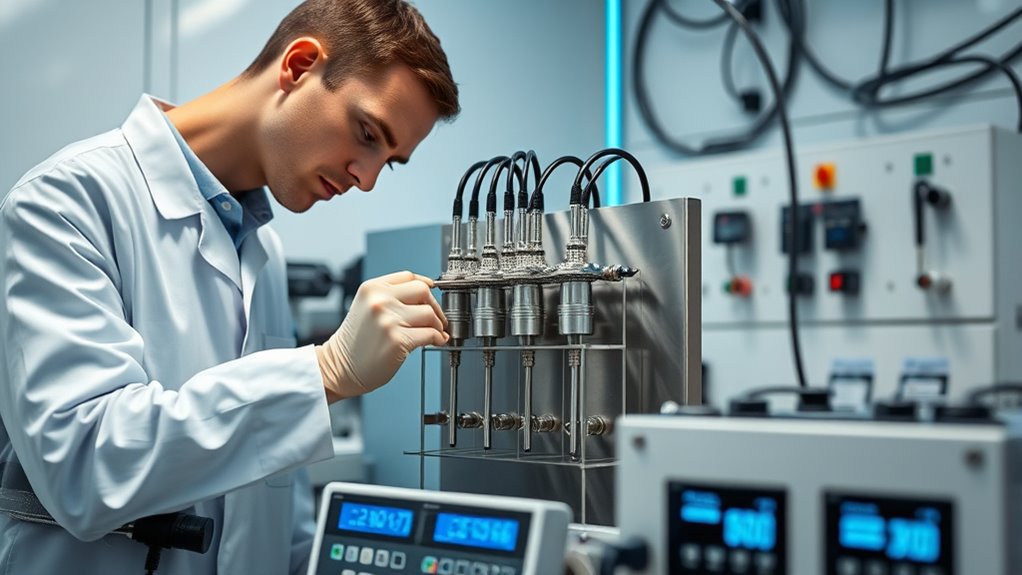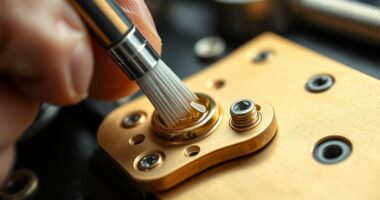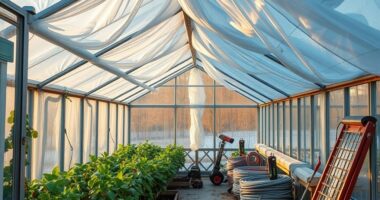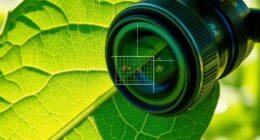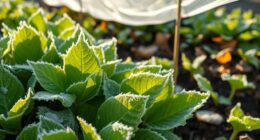To properly calibrate sensors, you need to control environmental factors like temperature, humidity, wind, and sunlight during the process. Use shields, enclosures, or conduct calibration in a controlled environment to minimize disturbances. Regular calibration and monitoring help maintain accuracy despite environmental changes. Many sensors also feature built-in compensation. Paying attention to these details guarantees reliable data over time. Keep exploring, and you’ll discover more effective techniques to optimize sensor performance in varying conditions.
Key Takeaways
- Perform calibration in a controlled environment to minimize temperature, humidity, and external influences.
- Use shielding, enclosures, or environmental chambers to protect sensors during calibration.
- Regularly monitor environmental conditions alongside sensor outputs to detect drift or calibration needs.
- Apply built-in or software-based compensation algorithms to correct environmental effects on sensor data.
- Schedule calibration sessions during stable environmental periods to ensure consistent and accurate results.
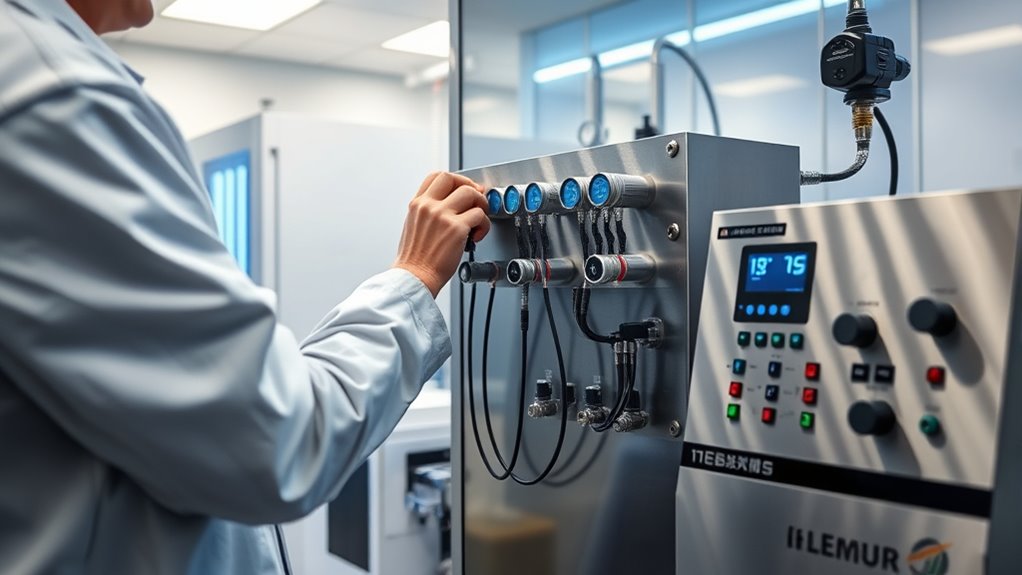
Calibrating sensors is essential to guarantee they provide accurate and reliable data. When you properly calibrate your sensors, you ensure that the measurements you obtain truly reflect the real-world conditions they’re designed to monitor. Sensor accuracy is critical in applications ranging from industrial automation to environmental monitoring, where even small discrepancies can lead to significant errors or faulty decisions. Achieving high sensor accuracy depends not only on the calibration process itself but also on maintaining environmental stability around your sensors. Fluctuations in temperature, humidity, and other environmental factors can cause sensors to drift over time, reducing their precision and reliability. That’s why controlling environmental conditions is a fundamental part of effective sensor calibration.
Proper sensor calibration and stable environmental conditions are key to ensuring accurate, reliable measurements over time.
When you calibrate sensors, you align their output with a known standard or reference. This process involves applying a precise input signal and adjusting the sensor until its readings match the reference. Regular calibration ensures that your sensors continue to deliver accurate data, especially as they age or experience environmental stress. If you neglect calibration, or ignore environmental stability, your measurements can become inconsistent, leading to errors that compromise your data integrity. For example, temperature swings can cause sensor drift, making readings unreliable unless you compensate for these variations during calibration. By establishing a stable environment—using temperature-controlled chambers or humidity regulation—you reduce variables that could skew your calibration results.
Maintaining environmental stability during calibration is equally important. Even minor environmental fluctuations can affect sensor performance, so it’s best to perform calibration in a controlled setting. This helps ensure that the calibration process is consistent and that the sensor’s response is measured under known, stable conditions. If you need to calibrate sensors in the field, take steps to minimize environmental disturbances. Use shielding or enclosures to protect sensors from wind, dust, or direct sunlight, all of which can influence readings. Additionally, scheduling calibration during periods of minimal environmental change improves the accuracy and repeatability of your results.
Furthermore, understanding how environmental factors influence sensor behavior allows you to implement compensation techniques. Some sensors have built-in temperature compensation, but for others, you might need to apply correction algorithms during data processing. Regularly monitoring environmental parameters alongside your sensors helps you identify when calibration adjustments are necessary. This proactive approach ensures your sensor data remains precise and trustworthy over time. Ultimately, by prioritizing sensor calibration and environmental stability, you lay the foundation for high-quality measurements, enabling informed decisions based on accurate, dependable data. Incorporating environmental controls into your calibration routine can significantly enhance the reliability and longevity of your sensors.
Frequently Asked Questions
How Often Should Sensors Be Recalibrated for Optimal Accuracy?
You should recalibrate sensors every 6 to 12 months for maximum accuracy, depending on their lifespan and usage conditions. Regular calibration ensures sensors maintain their precision, preventing drift that can compromise data quality. Keep an eye on manufacturer recommendations and monitor sensor performance regularly. Adjust your calibration frequency if you notice inconsistent readings or environmental changes, ensuring your system stays reliable and accurate over time.
What Are Common Signs of Sensor Calibration Drift?
You might notice sensor calibration drift through inconsistent readings, sudden signal fluctuations, or decreased accuracy over time. Sensor aging can cause the sensor to become less responsive, while signal interference from nearby equipment or environmental factors can disrupt data. If you observe these signs, it’s a good idea to recalibrate your sensors promptly, ensuring your environmental controls stay accurate and reliable. Regular checks help prevent issues caused by aging and interference.
Can Calibration Be Performed Remotely or Only On-Site?
You can perform calibration both remotely and on-site. Remote calibration allows you to adjust sensors from a distance using specialized software, which is convenient for hard-to-reach locations. On-site calibration involves physically accessing the sensor to make precise adjustments. While remote calibration is effective for many sensors, some require on-site calibration for accuracy, especially if physical components need inspection or replacement.
What Tools Are Essential for Accurate Sensor Calibration?
You need essential tools like a reliable reference standard or calibration device to guarantee sensor precision during calibration procedures. A calibration kit, which includes known standards, helps verify sensor accuracy. Use a multimeter or specialized calibration software to monitor and adjust readings precisely. By following proper procedures with these tools, you ensure your sensors deliver accurate data, maintaining ideal performance and preventing errors caused by drift or inaccuracies.
How Does Environmental Control Affect Sensor Calibration Stability?
Environmental control greatly impacts sensor calibration stability because humidity interference and temperature fluctuations can cause readings to drift. By maintaining consistent humidity levels and applying temperature compensation, you guarantee your sensors remain accurate over time. Controlling these factors minimizes measurement errors and reduces the need for frequent recalibration. You should monitor environmental conditions closely and adjust your calibration procedures accordingly, ensuring reliable and stable sensor performance in any environment.
Conclusion
Now that you’ve calibrated your sensors and environmental controls, you’re well on your way to ensuring accurate readings. Remember, precision is key to reliable data, so don’t cut corners. Keep regular checks to stay ahead of any issues. When it comes to sensor calibration, you’ve got to stay vigilant—if you don’t, you could be chasing your tail. Stay consistent, and your system will perform smoothly, proving that a stitch in time really does save nine.
